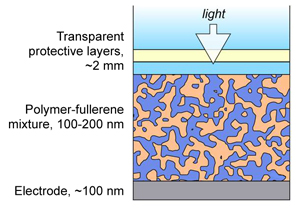A new type of commercial solar cell – cheap, flexible and easy to manufacture – is closer than ever to becoming a reality thanks to recent research at the US National Institute of Standards and Technology (NIST).

A new type of commercial solar cell – cheap, flexible and easy to manufacture – is closer than ever to becoming a reality thanks to recent research at the US National Institute of Standards and Technology (NIST).
Organic photovoltaic cells, based on organic fibers used to capture solar radiation and convert it into electricity, are a thriving field of research because they have significant advantages compared to conventional rigid form cells. A photovoltaic cell (PV) or solar cell is a solar device for the direct production of electrical energy by absorbing electromagnetic radiation from the sun. The disadvantage of the method is the relatively high cost of producing electricity, since the price of the photovoltaic panels is still relatively high.
These organic cells begin as a type of ink that can be infused into flexible surfaces to create solar cell components that can be rolled out over large areas as easily as we roll out a carpet. Although they are supposed to be cheaper to manufacture and more suitable for a wide range of energy applications, their commercial market size is limited, until the technology improves.
Even the most efficient cells of this type that exist today convert only less than six percent of the radiation reaching them into electricity and are durable for only hundreds of units of hours. "The industry believes that if these cells reach a ten percent survival rate and a lifespan of ten thousand hours, the adoption of the technology will accelerate significantly," says one of the researchers. "However, in order to improve them, there is an essential need to characterize the processes that occur in the material itself - and at this point we are only at the beginning of the road."
The aforementioned research team has advanced this understanding with their newest efforts, which provide a powerful new measurement method for organic photovoltaic cells and which reveals ways to control their preparation. In the most common family of cells of this type, the "ink" is a mixture of a polymer, which absorbs sunlight and releases its electrons, and a football-like substance, called a fullerene, which captures these electrons. When the ink is injected into the surface, the mixture fuses into a coating containing an irregular network of polymers mixed with the fullerene particles. In normal devices, it is desirable that the entire polymer network reaches the bottom of the coating while it is desirable that the fullerene components all reach the other side, so that the electricity can flow in the right direction out of the device. However, if fullerene complexes are formed between the polymer layer and the lower edge of the sheath, then the cell efficiency decreases.
Using X-ray absorption measurements of the layer interface, the team discovered that by changing the nature of the electrode surface, the fullerenes would be repelled from it (similar to the repulsion between water and oil) while the polymers would be attracted to it. The electrical properties of the interface also change sharply. The resulting structure provides the electron stream originating from the light radiation with more opportunities to reach the appropriate electrodes and also reduces the accumulation of the fullerenes at the bottom of the coating - two significant changes that may improve the cell's efficiency and longevity.
"We were able to identify some of the key factors required to improve the behavior at both ends of the coating, which means that the industry will have an effective method for improving the overall performance of the cells," explains one of the researchers. "Currently, we are basing ourselves on the information we have generated regarding the edges of the coating to understand exactly what is happening in the entire area of the coating. This knowledge is extremely important for the industry in order to understand how organic solar cells work and wear out and for the development of more efficient and longer-lasting cells."

6 תגובות
To Job
developing?
Every day you hear about progress
And I still haven't heard of a sixth use
It is a pleasure to see this field develop
Oh, and thanks for the article! 😀
There is an error in the link to the original article. You brought the link again to the article about "self-repairing coating layers"
I wish that the development would be found that would raise the survivor and that the whole world would switch to it already!
Organic again?